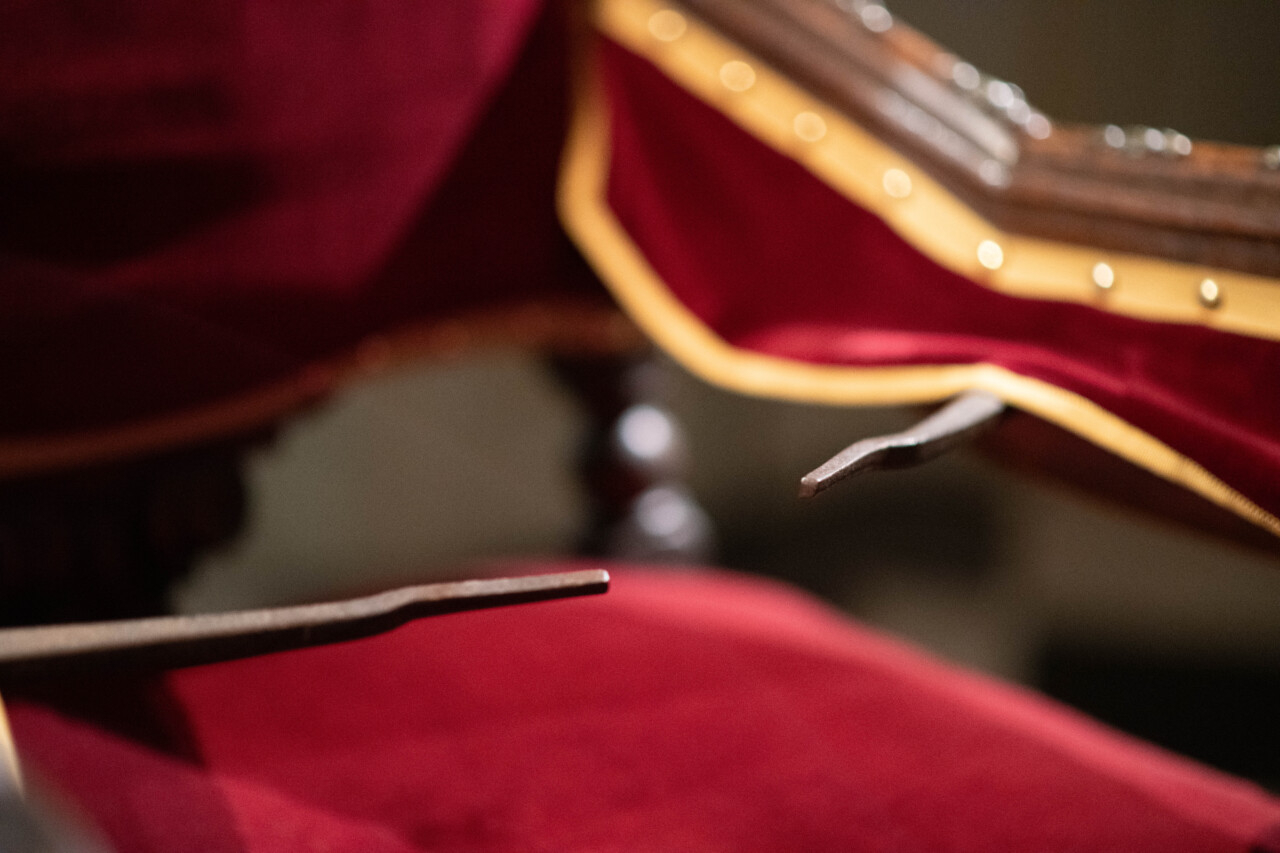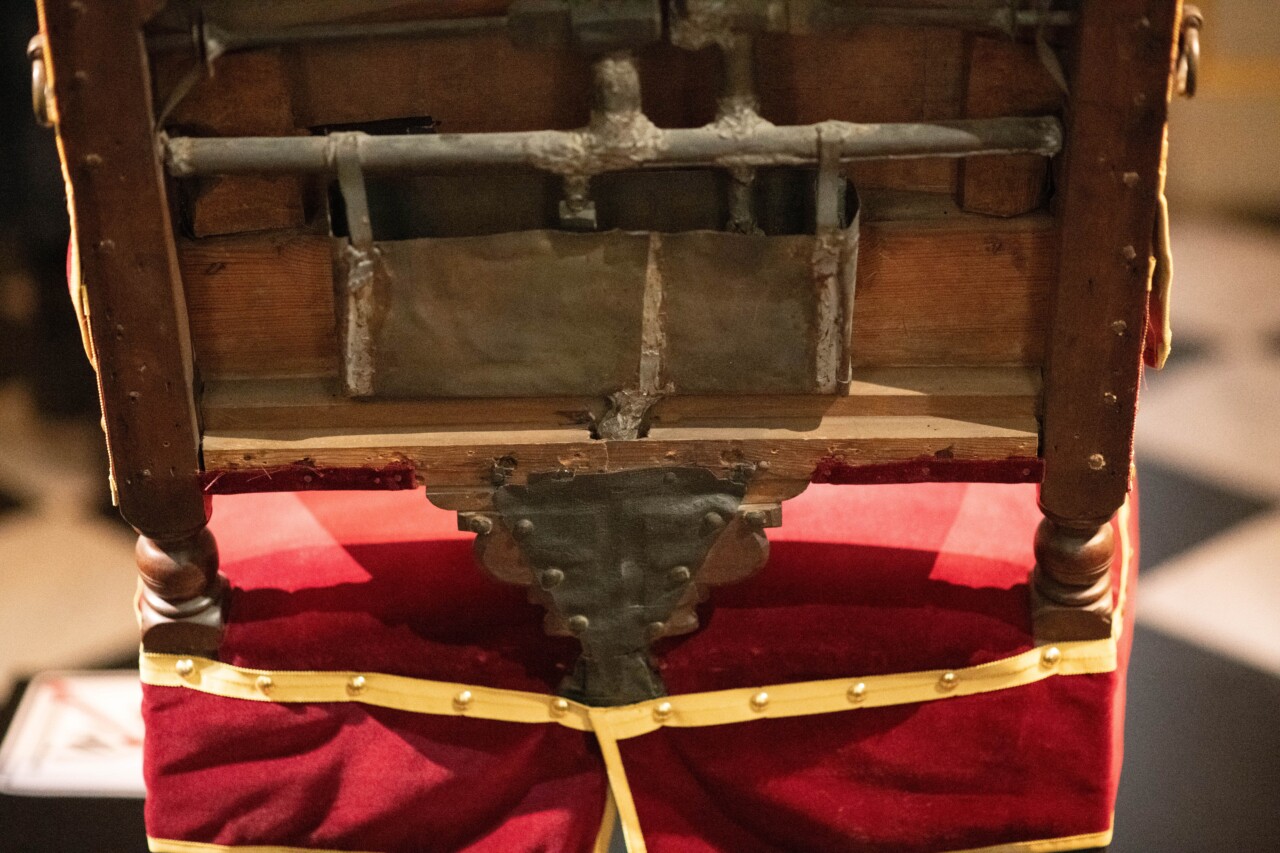Universitetsavisen
Nørregade 10
1165 København K
Tlf: 35 32 28 98 (mon-thurs)
E-mail: uni-avis@adm.ku.dk
—
Science
Pranks and frivolity — As students, they were tour guides at Rosenborg Castle, where visitors were fascinated by a prank chair from the royal court. Now, as two young researchers, they set out to uncover the story behind an elaborate trick.
Imagine taking a seat in an elegantly decorated chair at court in the late 1600s — only to be trapped, soaked, and made a laughingstock in front of the king and his guests. Such a chair actually existed at the court of Danish King Christian V, where it was used to entertain the court at others’ expense. But was it merely an innocent prank, or part of a more sophisticated power play?
The researchers behind the study
Louise Kjærgaard Depner is a historian and PhD student at the Saxo Institute at the University of Copenhagen (UCPH).
Casper Thorhauge Briggs-Mønsted is an art historian and PhD student at the Department of Arts and Cultural Studies at UCPH.
Their research on the so-called trouser watering chair has been written up into an article that has won The Society for Court Studies Early Career Researcher Essay Prize, and their academic article will now be published in the scholarly journal The Court Historian.
The two researchers hope that their work will lead to the discovery of more chairs like this at castles and courts across Europe.
This is one of the questions that PhD students Louise Kjærgaard Depner and Casper Thorhauge Briggs-Mønsted asked themselves in their effort to understand the so-called trouser watering chair which is at Rosenborg Castle in Copenhagen.
Their interest in the chair was set off when they worked as tour guides at the Renaissance castle during their master’s studies.
»It was always one of the objects that fascinated visitors the most during our tours. It has been known as the trouser watering chair [or ‘buksevandsstol’ in Danish] for many years. And just the name itself intrigued people. But in reality, we knew very little about its origins or its use,« says Louise Kjærgaard Depner.
Later, when they both secured PhD positions, they decided to investigate the chair in more depth. What started as simple curiosity quickly evolved into an extensive research project.
»We kept expecting to stumble upon an old book or article where someone had already provided an explanation for the chair’s history and significance in its own time. But that just never happened. We eventually realized that we were piecing together strands of evidence that no one before us had connected,« says Casper Thorhauge Briggs-Mønsted.
The trouser watering chair was almost certainly part of Christian V’s court in the late 1600s. But how did a prank chair like this even find its way into the otherwise solemn royal court? According to the researchers, humour and power were inextricably linked together within the culture of the absolute monarchy.
»When we think of the royal court, we imagine a strictly hierarchical environment with rigid rules dictating who could do what. And it was. But precisely because of this, the court also needed moments where these rules could be temporarily broken. The trouser watering chair may well have been part of this dynamic,« explains Louise Kjærgaard Depner.
Another example of this practice can be found in a tradition at Christian V’s hunting parties. Here, a participant who had infringed upon the rules for hunting would be publicly humiliated by being ordered to lean over the slain stag, after which the king would strike him on the backside with a staff.
»This was a great source of amusement for the court — but it also underscored that the king had the power to humiliate and tease his own men, even in informal settings,« says Louise Kjærgaard Depner.
The trouser watering chair likely functioned in a similar way: a temporary suspension of hierarchy, where everyone could laugh — but only for as long as the king permitted it.
At the same time, the trouser watering chair fits into the entertainment culture of Christian V’s court. According to the researchers, the king was heavily influenced by his mother, Queen Sophie Amalie, who was known for her lavish parties and costume games.
»At court, they loved to dress up, celebrate, and amuse themselves — and to challenge the hierarchy for a moment. The trouser watering chair perfectly fits into this play with social roles, which was a hallmark of his court,« says Louise Kjærgaard Depner.
Apart from its social function, the chair was also impressive for its time in terms of its technology. It contains a mechanism that automatically triggers restraining arms, bellows that simulate a farting sound, and a water tank that could be emptied over the unsuspecting guest.
»This kind of mechanism was also a demonstration of power. It was truly an elite object, and people were fascinated by mechanics in every possible way. So you could speculate whether being subjected to its mechanism was, in some sense, also a mark of honour,« says Casper Thorhauge Briggs-Mønsted.
The research into the chair has not been without challenges. The two researchers have had to piece together its history from sparse sources.
»We have not found a source that explicitly describes how the chair was used. So we have had to piece the puzzle together based on descriptions of Christian V’s court culture,« says Louise Kjærgaard Depner.
Their research has revealed that the trouser watering chair at Rosenborg was not a unique curiosity. It was part of a European tradition for mechanical pranks, which could also be found at courts in Austria, Italy, and England. When the researchers reached out to Schloss Ambras in Austria and Villa Borghese in Italy, everyone was surprised — both museums had believed they were the only ones in possession of such a chair.
One particular description from Italy recounts how an English guest sat down in a trap chair in front of a beautiful painting — only to discover that he was stuck.
»If no one had let me out, I would still be sitting there,« he wrote.
While the trouser watering chair may have been a popular feature at the Danish court of the 1600s, perceptions of it have changed over time.
»When the chair was added to the king’s cabinet of curiosities in 1752, its upholstery was so worn that it had to be replaced. This suggests that it had been used frequently. But over time, it came to be seen as being too crude. And by the 19th century, it had been completely hidden away,« says Louise Kjærgaard Depner.
Today, the chair is once again a subject of fascination — not only for its humorous aspect but for what it reveals about a time when power and amusement went hand in hand.
»The trouser watering chair is a perfect example of how we can use material objects to understand the social dynamics of the past. It is as if humour, hierarchy, and the fascination with technology all come together in this one artefact, which also sets off a reflection over when something is funny and when it becomes humiliating. These are, in fact, very universal and timeless questions — even today,« says Casper Thorhauge Briggs-Mønsted.
The chair is featured in a small special exhibition at Rosenborg Castle, where its mechanisms are demonstrated through animations and sound effects. This lets you get a sense of what it was like to be caught in the court’s most infamous chair — without getting your trousers wet.


